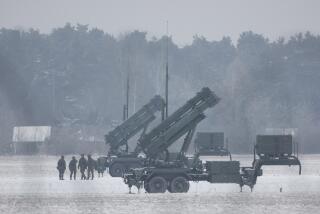War’s stunning price tag
- Share via
LAST WEEK, at the annual meeting of the American Economic Assn., we presented a new estimate for the likely cost of the war in Iraq. We suggested that the final bill will be much higher than previously reckoned -- between $1 trillion and $2 trillion, depending primarily on how much longer our troops stay. Putting that into perspective, the highest-grossing movie of all time, “Titanic,” earned $1.8 billion worldwide -- about half the cost the U.S. incurs in Iraq every week.
Like the iceberg that hit the Titanic, the full costs of the war are still largely hidden below the surface. Our calculations include not just the money for combat operations but also the costs the government will have to pay for years to come. These include lifetime healthcare and disability benefits for returning veterans and special round-the-clock medical attention for many of the 16,300 Americans who already have been seriously wounded. We also count the increased cost of replacing military hardware because the war is using up equipment at three to five times the peacetime rate. In addition, the military must pay large reenlistment bonuses and offer higher benefits to reenlist reluctant soldiers. On top of this, because we finance the war by borrowing more money (mostly from abroad), there is a rising interest cost on the extra debt.
Our study also goes beyond the budget of the federal government to estimate the war’s cost to the economy and our society. It includes, for instance, the true economic costs of injury and death. For example, if an individual is killed in an auto or work-related accident, his family will typically receive compensation for lost earnings. Standard government estimates of the lifetime economic cost of a death are about $6 million. But the military pays out far less -- about $500,000. Another cost to the economy comes from the fact that 40% of our troops are taken from the National Guard and Reserve units. These troops often earn lower wages than in their civilian jobs. Finally, there are macro-economic costs such as the effect of higher oil prices -- partly a result of the instability in Iraq.
We conclude that the economy would have been much stronger if we had invested the money in the United States instead of in Iraq.
Spending up to $2 trillion should make us ask some questions. First, these figures are far higher than what the administration predicted before the war. At that time, White House economic advisor Lawrence Lindsey was effectively fired for suggesting that the war might cost up to $200 billion, rather than the $60 billion claimed by the president’s budget office. Why were the costs so vastly underestimated? Elsewhere in the government, it is standard practice to engage in an elaborate cost-benefit analysis for major projects. The war in Iraq was a war of choice, an immense “project,” and yet it now appears that there was virtually no analysis of the likely costs of a prolonged occupation.
Could we have fought the war in ways that would have protected our troops better and cost the country less? A Pentagon study apparently concludes that better body armor would have prevented many deaths and injuries. Penny-pinching in such matters during the rush to war has led to steep long-run costs for the nation and, tragically, for the individuals involved.
Even more fundamentally, there is the question of whether we needed to spend the money at all. Thinking back to the months before the war, there were few reasons to invade quickly, and many to go slow. The Bush policy of threatened force had pressured Iraq into allowing the U.N. inspectors back into the country. The inspectors said they required a few months to complete their work. Several of our closest allies, including France and Germany, were urging the U.S. to await the outcome of the inspections. There were, as we now know, conflicting intelligence reports.
Had we waited, the value of the information we would have learned from the inspectors would arguably have saved the nation at least $1 trillion -- enough money to fix Social Security for the next 75 years twice over.
More to Read
Inside the business of entertainment
The Wide Shot brings you news, analysis and insights on everything from streaming wars to production — and what it all means for the future.
You may occasionally receive promotional content from the Los Angeles Times.










